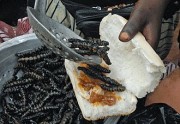Nope, not Mephitis mephitis the American skunk today, folks. Today we treat rather of the post-WWII aerospace industry as jewelled by Lockheed Corporation, before its 1995 merger to become today's Lockheed-Martin behemoth. In 1933, Lockheed employed a star engineer called Kelly Johnson fresh out of college. This guy had an uncanny feeling for aeronautics: he could intuit what normal folks had to get out their slide-rules to calculate. In WWII, his team developed the P-38 Lightning and USA's first jet fighter the P-80 Shooting Star.

But he is most well-known for ring-fencing a chunk of Lockheed equity in an autonomous entity, Advanced Development Projects, for creating super secret super planes for The Feds. ADP became known affectionately as The Skunk Works. Johnson was not an empath and he took no prisoners but if you could deliver, he'd back you and pay top dollar to keep you. Skunk Works pushed the envelope to create airplanes which were far beyond the technical capabilities of their aerospace competitors. More importantly, their U-2 spy plane and SR-71 almost rocket Mach 3 Blackbird were far beyond the reach of Soviet counter-measures.
Kelly Johnson retired in 1975 and handed over the reins to Ben Rich who had better people schools and kept producing sky-breaking novel planes until the end of The Cold War. I'm getting most of my info from his memoir Skunk Works: A Personal Memoir of My Years at Lockheed [1994] which I've just coursed through as a book-book. Reminds me of why they are called page-turners. In singing the praises of Lockheed's products, you might be tempted to think "he would say that, wouldn't he?" but the narrative is leavened with numerous Other Voices interludes where some of the dramatis personnae - pilots, engineers, politicians, air-force brass - get to add their 2c perspectives.
In the Rich years, Skunk Works most notably produced the F-117 Nighthawk stealth fighter, which was effectively invisible to radar [R]. The idea developed when one of the Lockheed engineers read and
understood a paper by
Пётр Я́ковлевич Уфи́мцев a Soviet engineer:
Method of Edge Waves in the Physical Theory of Diffraction. Insofar as I paid attention to boy things in the 1980s, I was super skeptical about a plane made out of polygons would return no signal to radar. But it was so: F-117s were famous for not being shot down.
Towards the end of the book Rich refers to irresponsible outlets in Western Europe for supplying weapons to small hostile countries. In the same paragraph he talks about tremendous losses to Soviet helicopters from shoulder-held Stinger missiles supplied by our own CIA. What is sauce for the Red goose is clearly not sauce for the Yankee gander. Where do people get off with their unconsidered certainties of being in the right??
In his memoir, Rich sets out his stall that Skunk Works was successful because it was not trammeled by paper-work. In those early days, everyone was believed to be on the same page - fighting them Reds - so the USAF would trust Lockheed - and other defense contractors - to deliver what they said they'd create . . . in budget . . . without (unpatriotic) feathering shareholders nests on tax-payer dollars. Proposals, tenders and procurement contracts were short and on message. In one anecdote Ben Rich, in retirement, goes to visit the USS "Old Ironsides" Constitution (launched 1797) in Boston Harbor. The old lady was undergoing a paint job and the site engineer admitted that 200 pages of documentation were required to make this happen. Rich pointed to a glass case displaying the original contract to build the whole damn ship . . . three copperplate pages!
Another key to Skunk Works success was the physical proximity of the engineers and draughtsmen [yup mostly men) with the machinists, welders, electricians and tool-setters on the shop-floor. If things didn't work / fit, the engineers could immediately go back to the drawing board. When each good pair of hands is respected and heard, everyone buys into the Project and mistakes are less like to fall between domains. Good book, recommend.




























